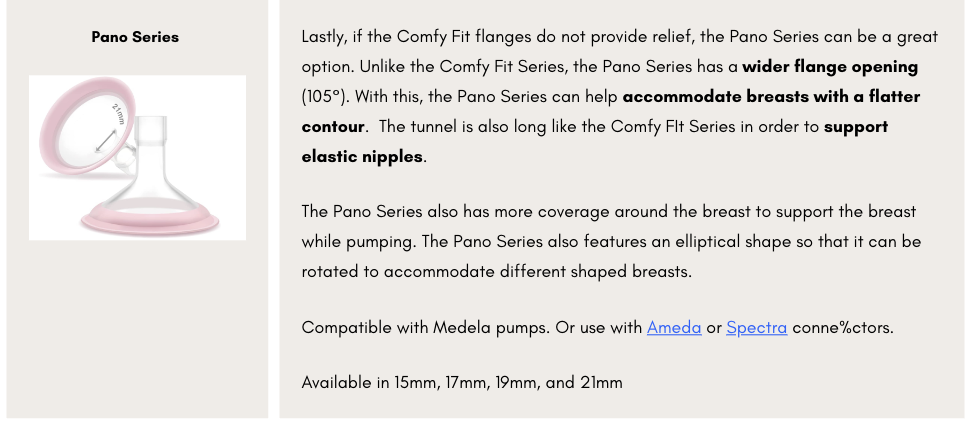Maymom Flanges: Which One Is Right For Me?
What Are Maymom Flanges?
Now at The Breastfeeding Center, you can find many different products by Maymom. If you have not yet heard of Maymom, it is a brand that makes pump parts that can be interchanged with many different pump brands. (For instance you can use connector pieces to make a Medela flange work with your Spectra, pictured to the right is the Maymom Base Spectra Connector).
Tip: Using a connector like Maymom’s can also be helpful if you are trying different flange sizes as you can interchange them with your Base Connector.
Maymom also makes a wide variety of flange sizes and additional parts that many major brands don’t make. For instance, Maymom has carries flange sizes from 13mm to 36mm. But how do you know which one might work best for you?
Where To Begin
Most brands come with a “standard” set of flanges. Some “standard” flanges that you will find in pump kits include,
Ameda Kits - 25mm
Baby Buddha - 24mm
Elvie Pumps - 24mm and 28mm
EvenFlo Kits - 30.5mm with 28mm or 24.5mm inserts
Medela Kits - 24mm
Motif Luna Kits - 24mm and 28mm
Pumpables Kits - able to choose your size (15mm, 17mm, 19mm, 21mm, 25mm, or 29mm)
Spectra Kits - 24mm and 28mm
Willow Pumps - able to choose your size (15mm, 17mm, 19mm, 21mm, 24mm, 27mm).
While these “standard” sizes may be suitable for folks for the duration of pumping, many parents find that they do need to adjust their flange at some point during their pumping journey.
Flange Sizing (sensations & diameters)
Flange sizing is best done during/after a pumping session, however, if you are trying to prep your pump parts prenatally, this can make things a little challenging. Online forums and many brand blogs (including Maymom) recommend measuring the nipple diameter. While this measurement can be used as a benchmark, it does not necessarily translate to your flange size. If you are using your nipple diameter measurement to gauge flange size, however, size up at least 2mm so that your nipple can move freely in the tunnel. (For example: if your nipple measures 15mm, try a 17mm flange).
Again, direct measuring for flange sizing is a benchmark. The best way to truly determine whether you have the right flange size, is by pumping with the flange itself. Flange sizing can also be done during an appointment with a Lactation Consultant at The Breastfeeding Center.
When you are looking for a well-fitting flange, there are a few things you should look for:
The nipple should be freely moving through the flange tunnel with slight space around the nipple so that it does not touch any side of the tunnel.
The areola is flat against the flange opening and no areaola tissue is being pulled into the tunnel.
There should be no friction or pain.
The breast is fully drained after a pumping session.
The breast tissue should constantly be in contact with the flange, sometimes incorrect flanges can create almost a “slingshot effect” with the breast tissue rubs against the flange while pumping.
Tip: To fully test a flange, you will want to complete one full pumping session to see how the nipple moves and feels, as well as see how much milk you are able to express.
Your flange is too large if:
Tissue from your areola is being pulled into the tunnel, causing the areola to rub against the tunnel
You feel discomfort even on a lower setting
You cannot get a good seal while pumping
You express less than you expect
The skin on your breast is irritated
Your flange is too small if:
Your nipple is running along the side of the tunnel
Pumping is painful, even on a slow or low suction
Milk flows slowly or less milk is pumped than expected
There is redness or discoloration after pumping
The nipple is misshapen after pumping
There is a ring around your breast that matches the flange
*Also note, there may be other factors that cause discomfort while pumping, however, checking your flanges can be a good place to start. If you do find that pain or discomfort persists, please meet with a Lactation Consultant for support.
Flange Fitting (considering breast shape)
Once you have a good idea of your flange size you might also want to consider your flange shape, which can help the flange contour to the breast in different ways. Maymom not only has many different flange size options, but they also have flange shape options as well. This can be helpful when considering breast shape during pumping. (For instance, while the Maymom Comfy flanges might be comfortable, someone with slightly larger breasts might benefit from the Maymom Pano Series, which will cover more of the actual breast tissue).
Tip: Elastic skin can also cause discomfort while pumping, meaning even if the diameter of the the tunnel of the flange feels right around the nipple, the areola and breast might still feel that it is being pulled through. Considering a different shaped flange can help provide more comfort and relief.
Comparing Maymom Flanges
Below is a comparison of each flange type by Maymom and why one might be more beneficial than the other:
Comfortable Pumping
Flange sizing can seem overwhelming with all the sizes and options. However, the overall goal of flange fitting is to find the most comfortable size and shape for your nipples and breasts. By having a comfortable and well-fitted flange, you can actually see an impact. Pumping without being able to fully express comfortably can cause issues with supply, which can be difficult for parents to cope with. Learning about all the factors that contribute to a pumping session can help you feel more in control and even empowered.
Some additional things you can do to make pumping more comfortable (outside of changing/adjusting your flange), include:
booking an appointment with a Lactation Consultant
using a pumping lubricant
using a flange insert (a silicone piece that fits inside a flange to reduce/adjust size)
adjusting your pump suction or changing to a different pump
and more!









